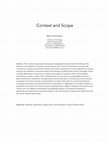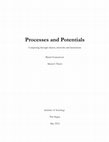Papers by Bjarni Gunnarsson

Proceedings of the SMC Conferences, Jul 4, 2018
Interaction with generative processes often concerns manipulation of their input and output or a ... more Interaction with generative processes often concerns manipulation of their input and output or a variation of predefined parameters that are part of a given process. One can think of algorithmic procedures as black boxes, it does not matter how they work if they serve in a useful way. Based on a black box model, generative processes can be instantiated, followed by a reflection of whether one accepts their results or not. This often involves an idea of completion. That an algorithm produces a result that has to be evaluated and treated accordingly. Creative activity, (such as musical composition) is arguably not such a clearly-defined process. Instead of progressing towards known goals, a compositional process might constantly develop and change shape. In such situations, generative algorithms are needed that interact with the ongoing creative activity. Algorithms that match (and take place within) the context of evolving and dynamic compositional processes. This paper presents a software framework that addresses the relationship between interaction and generative algorithms based on scheduling and computer process management. Algorithms that are partial and scheduled based on adaptive heuristics. Interrupt-based process management and context switching as a creative force.
xCoAx 2021 Proceedings, 2021
Digital sound synthesis can be described in terms of discrete operations applied to signals accor... more Digital sound synthesis can be described in terms of discrete operations applied to signals according to given criteria. The process of organising such operations can be subject to creative variation and generative algorithms. This article presents proposals for how a sound construction process can be thought of as a combination of synthesis and applied transformations. Operational spaces are examined and how process configuration and incompleteness can serve as creative models for synthesis. Properties of sound streams are also considered and how they can involve liveness and unpredictability. A software framework is finally introduced followed by a reflection on its use in creative practice.

Koncon RC, 2019
The context of generative processes encapsulates relevant data that influence the behavior of an ... more The context of generative processes encapsulates relevant data that influence the behavior of an algorithm including mental domains and 'internal' dimensions of a particular context such as goals and decision making. Of creative importance is how an algorithmic process reacts to the influence of its environment, the enclosing conditions from which it emerges. Given a clearly defined set of resources, a variety of processes can operate within the boundaries imposed by a certain context. Such a shared space can be seen as a composable structure, a space where both composition and generative activity take place. Contributing to the evolving properties of a certain situation, the persistence of state means that an environment behaves according to the previous activity that has occurred within it. Opposed to an amnesic situation, a persistent environment can resume previous developments, adapt to long-term interactions and evolve over time. Based on persistence and gradual change, the temporal unfolding of generative processes has an important impact on the becoming of compositional algorithms and the sound material they create.

SMC 2018, 2018
Interaction with generative processes often concerns manipulation of their input and output or a ... more Interaction with generative processes often concerns manipulation of their input and output or a variation of predefined parameters that are part of a given process. One can think of algorithmic procedures as black boxes, it does not matter how they work if they serve in a useful way. Based on a black box model, generative processes can be instantiated, followed by a reflection of whether one accepts their results or not. This often involves an idea of completion. That an algorithm produces a result that has to be evaluated and treated accordingly. Creative activity, (such as musical composition) is arguably not such a clearly-defined process. Instead of progressing towards known goals, a compositional process might constantly develop and change shape. In such situations, generative algorithms are needed that interact with the ongoing creative activity. Algorithms that match (and take place within) the context of evolving and dynamic compositional processes. This paper presents a software framework that addresses the relationship between interaction and generative algorithms based on scheduling and computer process management. Algorithms that are partial and scheduled based on adaptive heuristics. Interrupt-based process management and context switching as a creative force.

Institute of Sonology
This dissertation is concerned with strategies for composing computer music. It is motivated by a... more This dissertation is concerned with strategies for composing computer music. It is motivated by an interest in problems concerning the interaction and relationships between materials and processes and their influence on development and form. The main objective is to create a framework of ideas and technical solutions that could lead to novel possibilities when creating computer music and experiencing the compositional process. Different processes create musical compositions and an associative approach will be presented where the aim is to relate these various aspects. The relations occur by binding operative objects, control polarities, sound processes and networks together. These relations are interactive and dynamic where compositional focus is put on forming and manipulating these relationships. A compositional environment implementing these ideas will be introduced, along with a discussion of musical compositions inspired by them.






Uploads
Papers by Bjarni Gunnarsson